Chapter 1: The Problem
What I Observed, Goal of this Excercise.
What I Observed:Repetition turns into Desertion
I noticed how my friends abandoned movie plans when we couldn't find suitable screenings quickly. They had to manually gather timetables from each cinema franchise and do it again on a theatre by theatre basis.
When I asked around a bit more, it seemed that this repetitive task makes people reluctant, limiting their scope of screenings and eventually making them abandon plans.
Goal of this Excercise
So I wondered, What's the thought process of choosing a movie screening? Could a centralized movie screening listings fix this? If so, this would raise the complexity of choosing a screening by having so many options from many franchises. And that's how I got interested in exploring this mental model.
Roles & Dates: Done from Feb to May 2019. This was a personal excercise, including research, design and validations.
Skip to the PrototypeChapter 2: Research Plan
Objectives, Methods and Key Findings.
Objectives & Methods
-
Explore user's mental model on choosing a movie screening.
Explorative Research: Surveys, Interviews
Evaluative Research: Usability Tests
-
Identify the movie selection journeys by cinema franchises.
Explorative Research: Competitor Benchmarking
-
Estimate the volume of movie screenings of all cinema franchises.
Explorative Research: Field Study
-
Validate users' interest in a centralized movie ticketing app.
Evaluative Research: Concept Testing
Surveys & Interviews
Audience: Citizens of Tegucigalpa, Honduras, between the ages of 17 and 44, who go at least to the cinema once every three months.
These guerilla interviews were applied in parallel to the survey, most often surveyed individuals would gladly turn into interviewees. These were kept short no more than 10min. Around 100 surveys were done on-site by myself (at universities, shopping malls) and the rest via social media.
Key Explorative Findings
-
The Movie is King but Time is Queen
These are the users' most important criteria when choosing a movie screening.
-
Two Personae Archetypes
Those who go to the cinema for a specific movie and those who go as a casual activity with no movie in mind.
-
An impulse driven decision
81% of people buy movie tickets for the current day, within 4hrs before the movie starts.
-
Love or Hate, Subtitled vs Subbed
Interviewees expressed this is a mutually exclusive relationship, users who watch subtitled wont't watch dubbed movies and viceversa.
-
No Loyalty for Franchises
Cinema Franchise is a very low priority, ranking 6th of 7, but the location of theatre itself is important (ranked 3rd of 7).

The Current User Journey:Repetition turns into Desertion
Major frustration shows up in the middle of the journey, every time they realized they had to repeat the whole process because they wanted more options from more theatres. When in a group, some users delegate the task of gathering the timetables to various members, but more often people abandon the process just having the timetables of 1 or 2 theatres. If there are no suitable screening times then users would abandon the plan of going to the cinema.

What Cinema Franchises do now:Forcing Users to Make Decisions without the Necessary Information
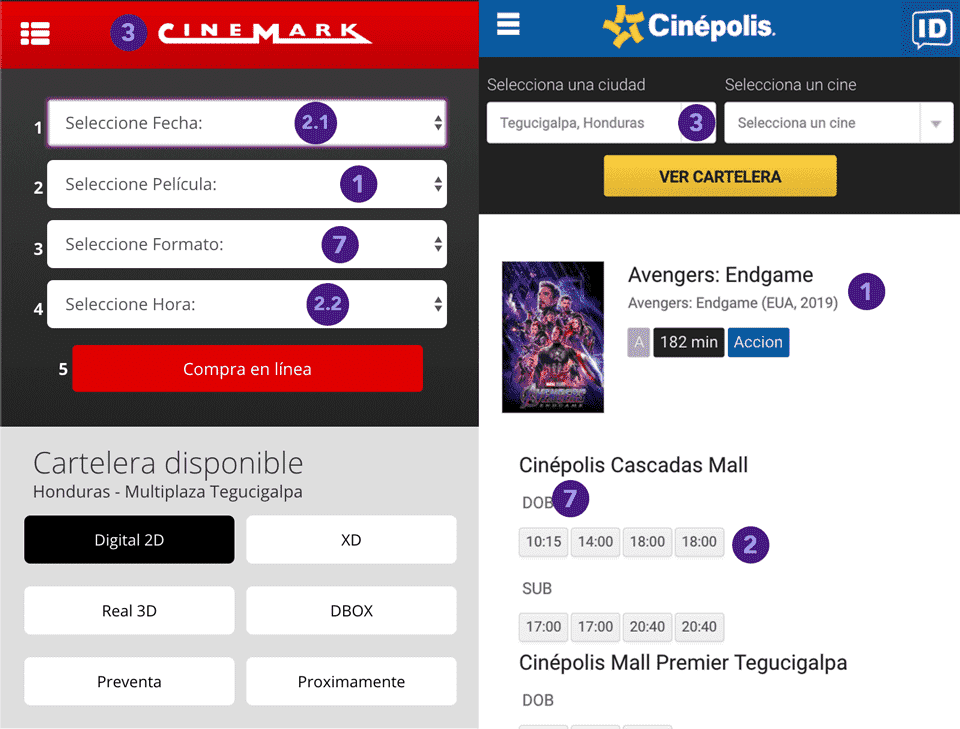
The most popular Cinema Franchises, Cinépolis and Cinemark, ask these criteria based on their company organization and not on users' priorities. Example: choosing a projection type first without knowing the available screening times.
Major Pain Points
-
Highly Repetitive:
In order to get options from multiple franchises, users have to repeat 6-7 steps per franchise. Getting options from 3 franchises could require up to 18 steps.
-
Screening times per theatre, not per franchise:
Most franchises don't display screenings including all their theatres, these are displayed on a theatre-by-theatre basis instead.
-
Screening times sorted by projection type:
Users need to check every projection type (2D, 3D, VIP) in order to find the screening times that match their needs.
Estimating Screenings Volume
All (8) theatre's timetables were sampled in Tegucigalpa, Honduras in order to estimate the overall amount of screenings available. The day sampled on the 2nd Friday of March, the busiest of the week.
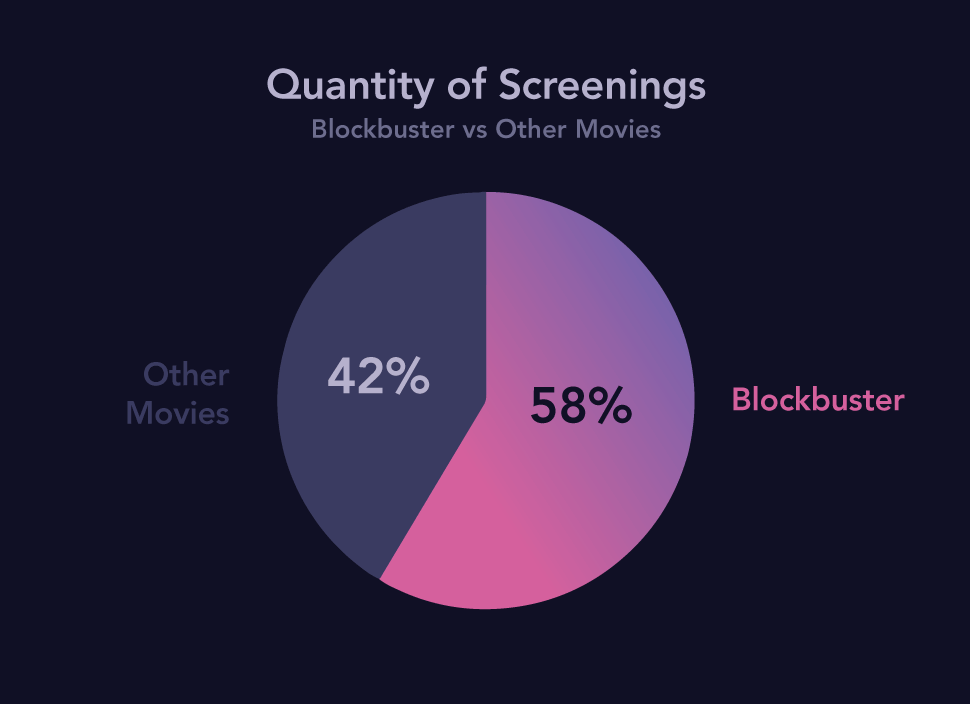
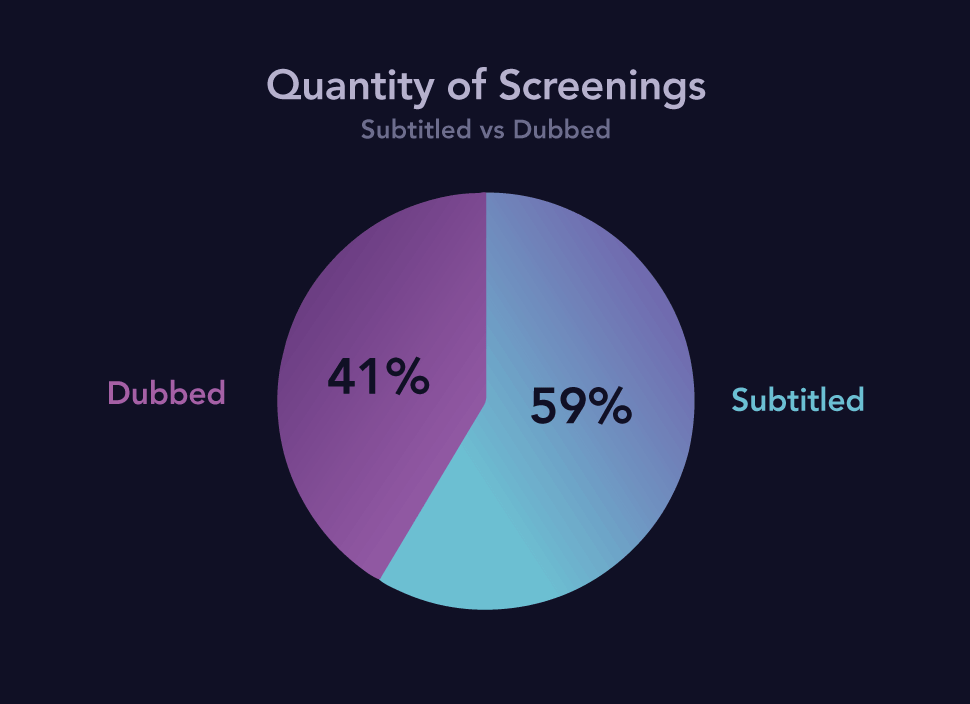
Blockbuster Threat: The Blockbuster movie of March 2019 (Captain Marvel) had 58% (81/140) of all screenings . Blockbusters can potentially overwhelm the user with so many options at a glance. All theatres projected from 3 to 6 different movies, therefore 42% of screenings for the 5 non-blockbuster movies.
Love or Hate, Subtitled vs Dubbed: 59% (82/140) of screenings are subtitled and 41% (58/140) dubbed. Interviewees expressed a love/hate relationship between these two. Most often being mutually exclusive, users who prefer subtitled won't watch dubbed movies and vice-versa.
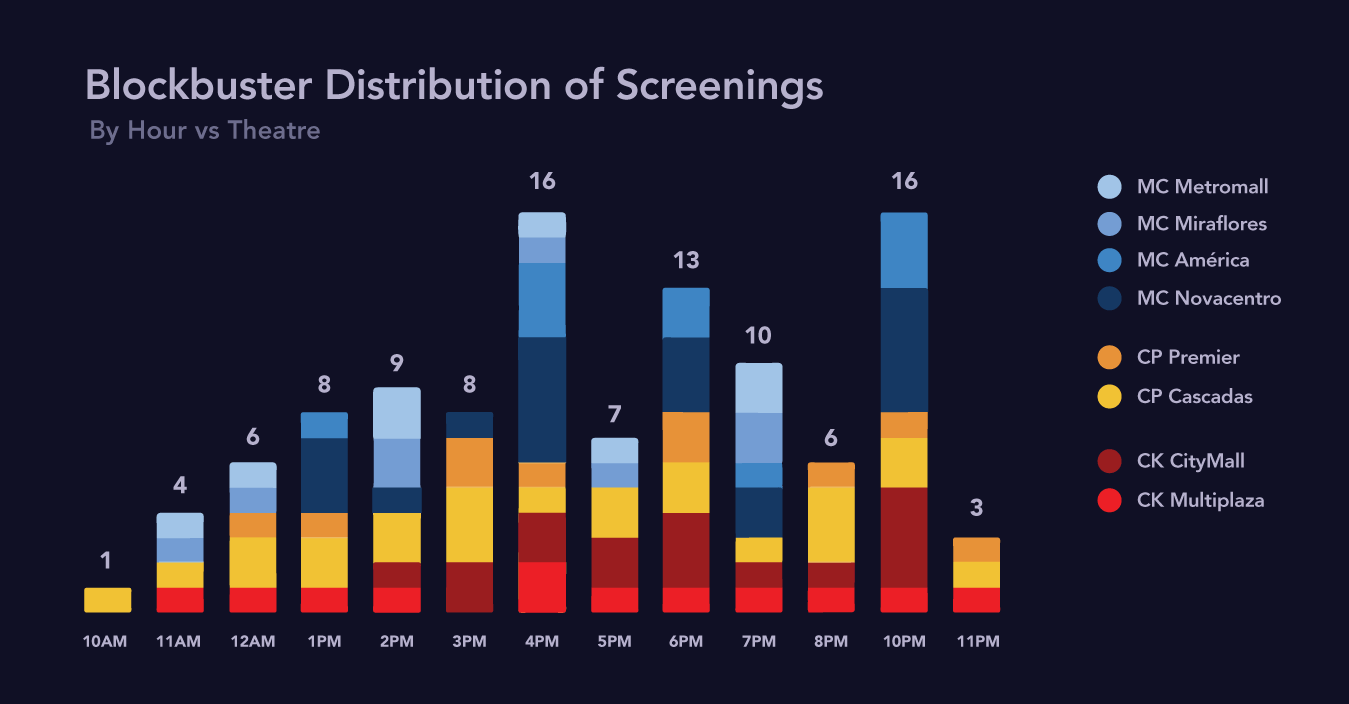
The Hours of Highest Demand: 35% of all blockbuster screenings peaked at these hours: 4PM (16), 6PM (13) and 9PM (16).
Chapter 3:Design Hypotheses
New User Journey, UI Designs.
Hypotheses
-
Rework Information Architecture:
By following user priorities, remove steps, predict most common choices and turn some required steps into optional ones.
Expected Outcome: A more natural, effortless and faster movie screening selection experience.
Evaluation Method: Usability Test.
-
An Alternate Journey for the Casual Persona:
Expected Outcome: A useful design variation for those users who want to go to the cinema but do not have a movie in mind, by aligning Timetables first, instead of the Movie.
Evaluation Method: Usability Test.
The New Proposed Journey:Follow the Mental Model, Skip and Anticipate Decisions

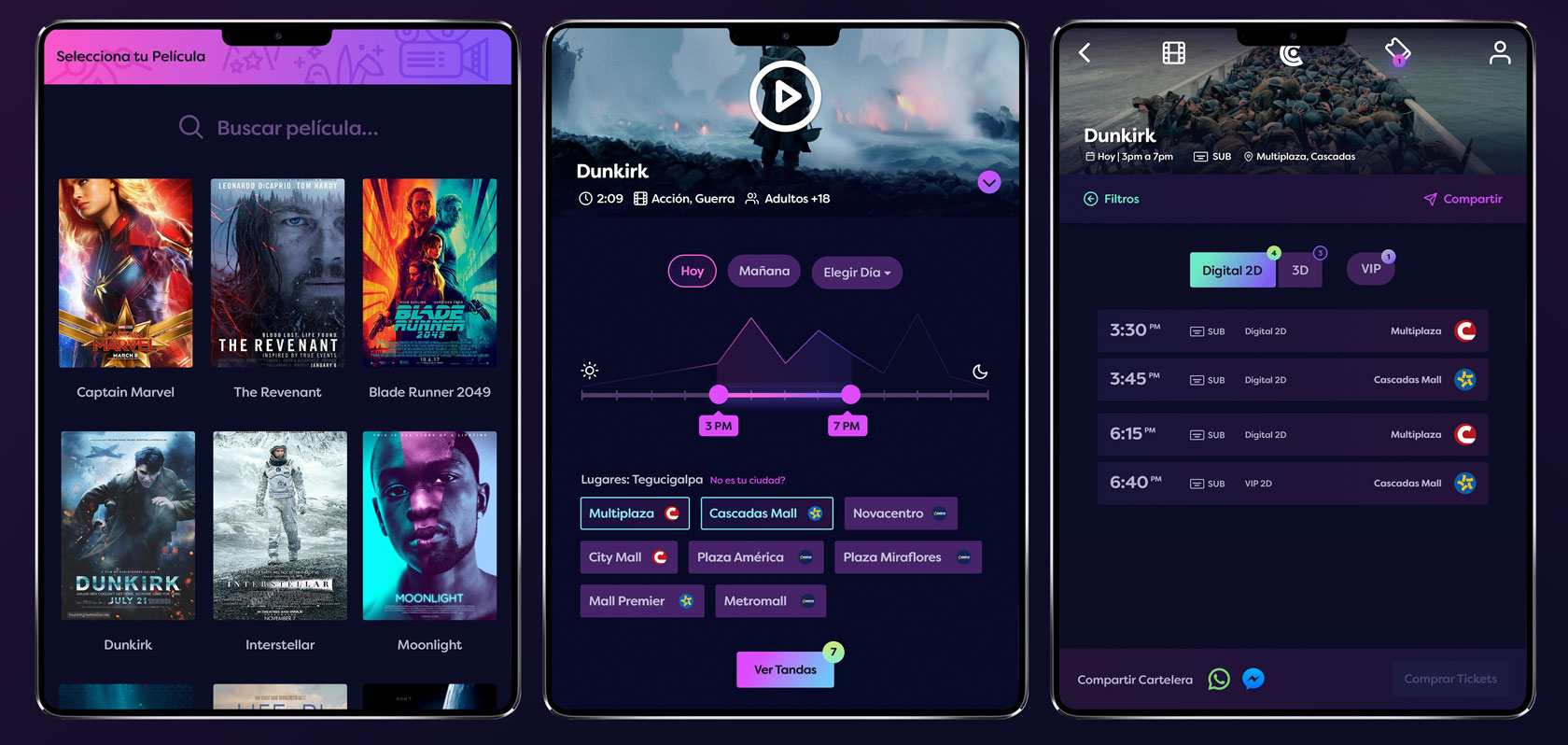
New Jobs to be Done
-
-Pre-determine City
Users could skip this step as it can be pre-determined via geo-location or IP address.
-
- Pre-determine Favorite Format
Users have a love/hate relationship on Subtitled vs Dubbed movies. Most often this is mutually exclusive, users who prefer subtitled won't watch dubbed movies and vice-versa. Users will mark their favorite format as part of the onboarding process.
-
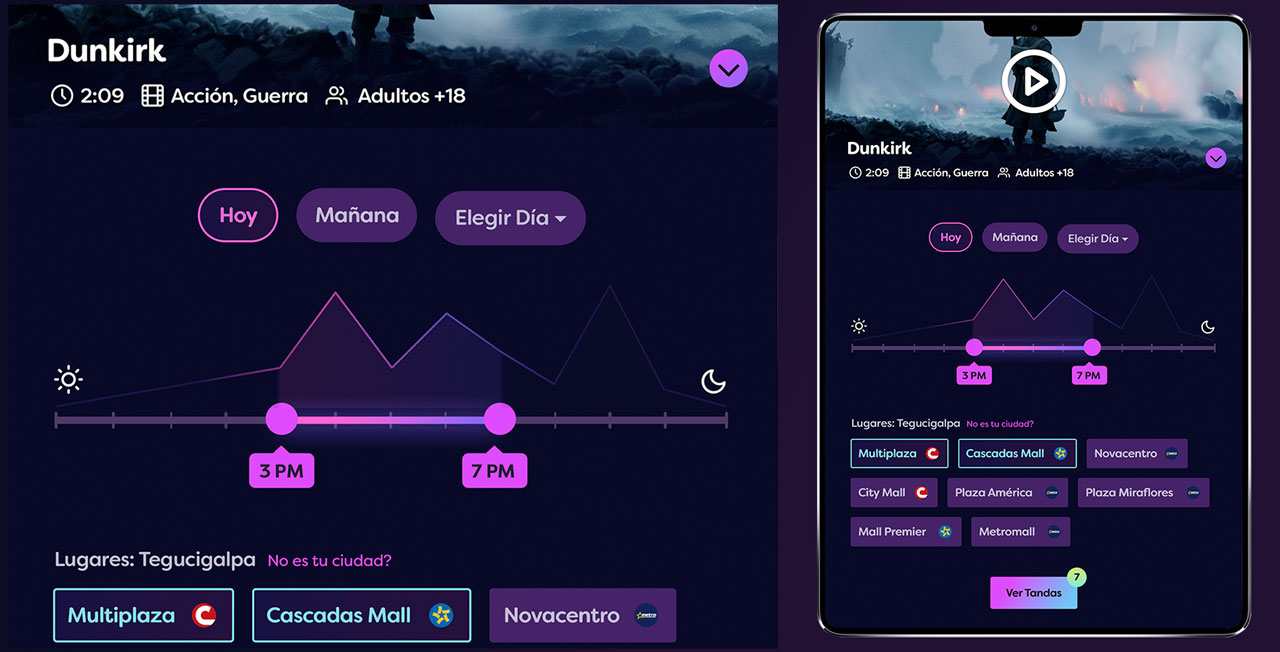
Step 2.1 Controls for Date: Today (default), Tomorrow or Choose a Day. The time slider will be preset to +4 hours of the current time. The graph indicates the amount of screenings available at that time. -
2.1 Confirm Date & Hours
Going to the cinema is an impulsive-driven decision, 81% of users buy tickets for the same day usually with 1-4 hours of anticipation. Instead of asking users, this can be set as default and allow them to modify it.
-
2.2Filter Theatres
Users' favorite theatres will be pre-selected but also allowing them to remove/add other theatres.
-
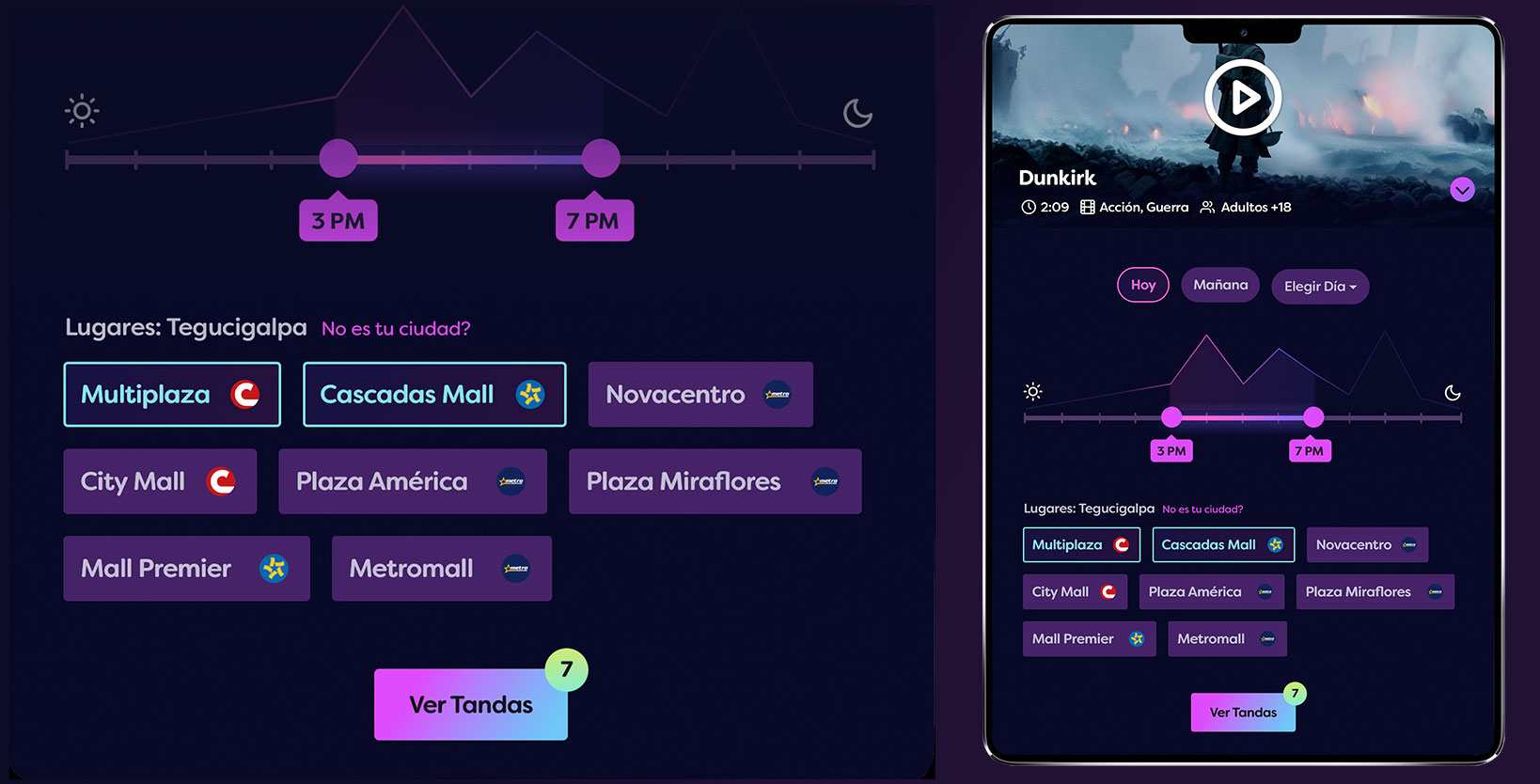
Central American cities are small (less than 400 km²) and have just a few theatres (less than 12), therefore a distance-driven sorting wouldn't have much impact. -
3 Enlisting Screenings
Time is the 2nd most important criteria, therefore screenings will be presented in chronological order.
-
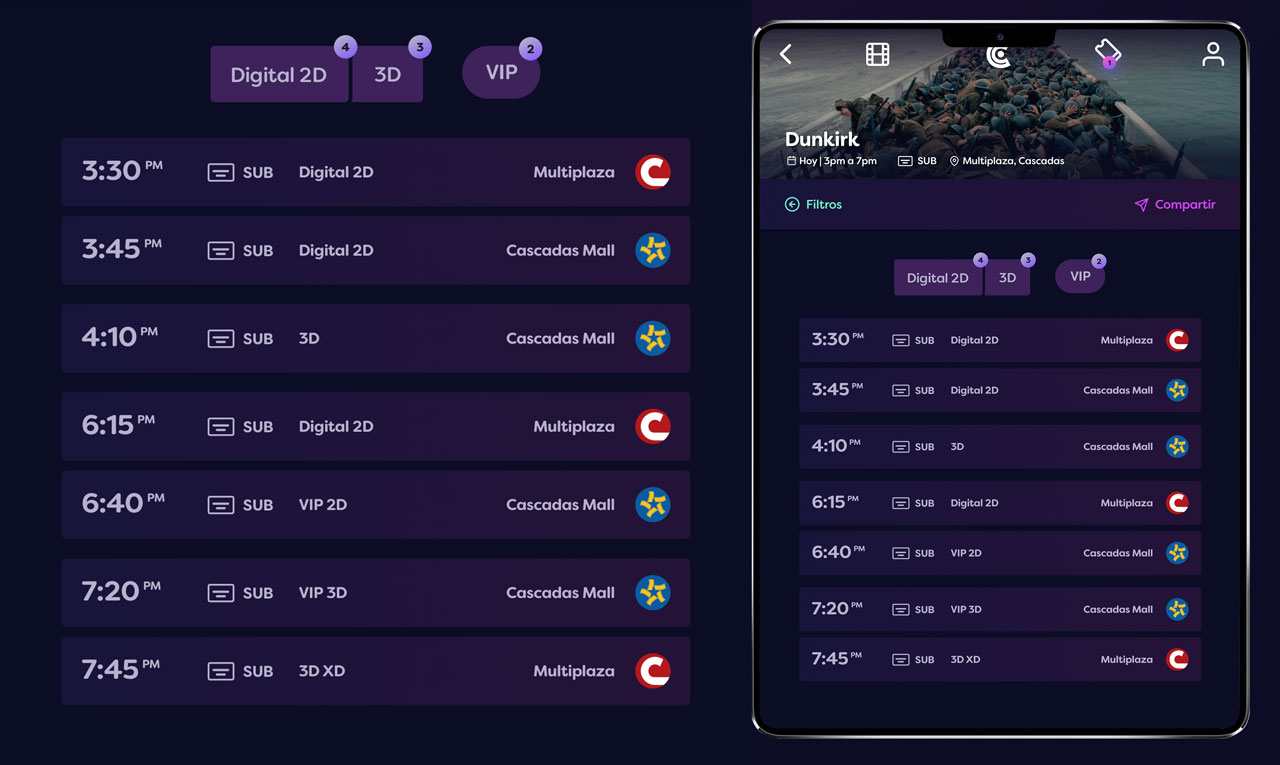
Screenings listed in chronological order. -
4 Screening Types
Given Screening Type is the least relevant criteria, then it will be shown as an optional filter at the end of the journey.
-
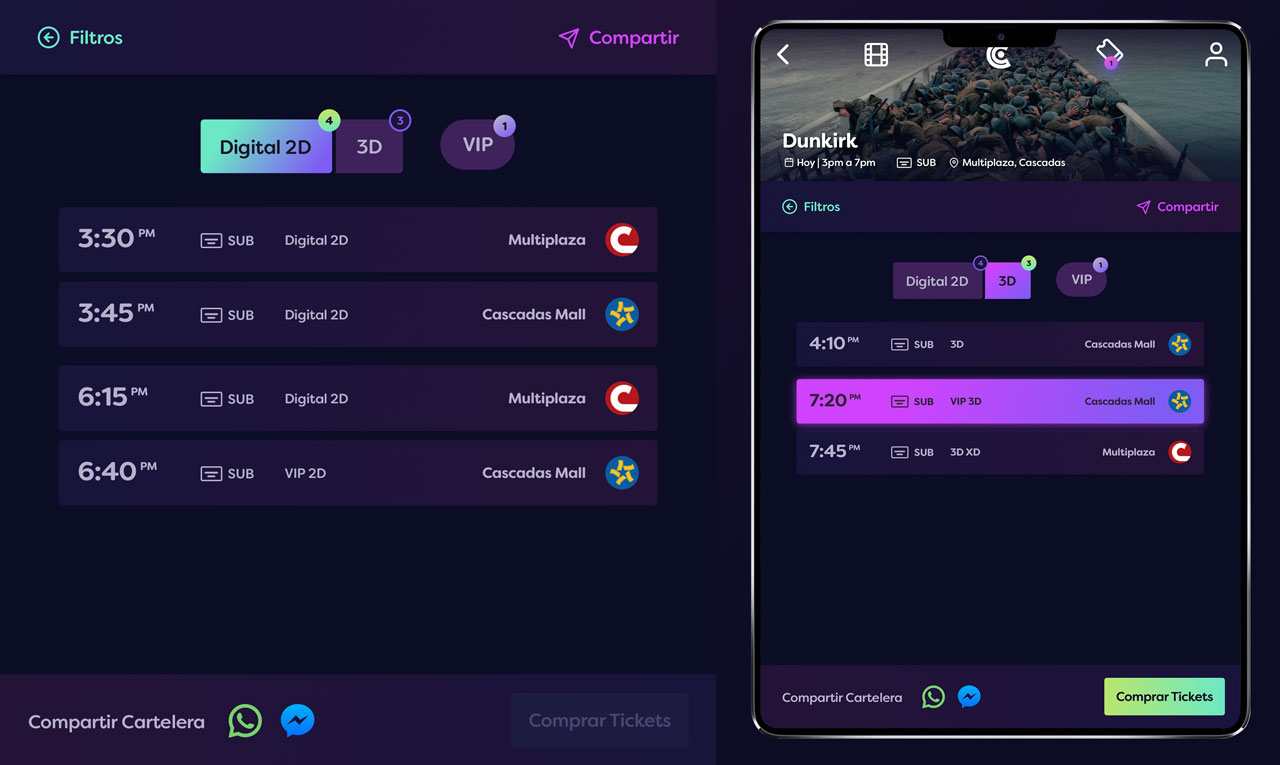
Optionally, allow users to filter by 2D/3D and VIP.
Chapter 4: Results & Validations
Results, Usability Tests, User Feedback.
Results: Failed and Successful Validations
-
Success: The New Movie Selection Journey
Praised by 13/16 users, it was described as "easy and pretty straightforward" and highlighted with excitment that screenings were sorted chronologically.
-
Failed: Multi Movie Timetables
Meant for the persona who didn't have a movie in mind, the idea was to show timetables including multiple movies. The amount of screenings shown could be absurdly high (+15). People confidently considered this overwhelming.
-
Unresolved: The Alternate Journey for the Casual Persona
Most users liked this approach but didn't express it in a very confident way. Other users described it as "a bit redundant" since the first journey also works well for this scenario. I consider clarity on this subject would require further investigation.
-
Success: A Centralized Movie Ticketing App Concept
14/16 Users confirmed this concept would ease the process, specially by having timetables of multiple franchises at a glance, and not in a theatre-by-theatre basis.
Usability Tests
Users quickle appreciated screenings being sorted chronologically and having all theatres from each franchise at a glance.Surprisingly the vast majority of issues were related to the UI itself, not about the paradigm. Therefore, most of the iterations were dedicated to polish this execution in terms of UI.
These iterations were most often conducted in a A/B Testing fashion, since users were very likely to describe something as "good" unless they had something to compare with.
Verbatims from User Feedback
-
I love the fact screenings are presented by hours!
-
Having fewer options made it so easier to make a decision. I love how I can filter out those things I don't care!
-
I didn't feel a difference between the 2 journeys. Schedule is very important to me but I pretty much choose the movie first anyways.
-
It feels pretty straightforward, it is very comfortable to have many options at a glance.
-
It's way easier than the apps of the cinemas. There's no reason not to use this app.
Chapter 5: Takeaways
What to Improve, Final Comments.
What to improve for next time
-
1Include real answers as part of the survey pilot:
Not only check if the questionnaire is healthy, oversample a bit so you can check any misunderstandings, patterns or anything weird revealed by the data.
-
2Pilot Surveys and Interviews in parallel:
I noticed some patterns from interviews that would have been great to validate via the survey. Same for the surveys, I would have loved to explore the reasons why of some patterns I saw in the data.
Final Comments
Following a mental model grants great results! Just keep in mind this will never be generic. External factors, such as market conditions and geo-demographics make a huge influence.
This mental model, where time is critical, makes sense for a small city, with a handful theatres and franchises. Apply this study in London or anywhere else and you will get very different results.
You really made it here? Seriously? Wow, thank you for reading! :)
